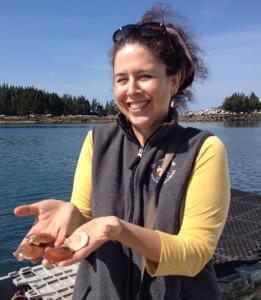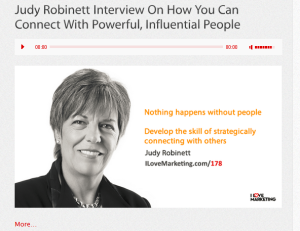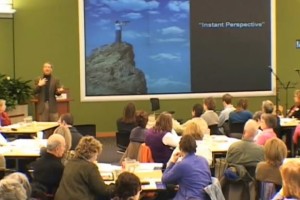 Just before heading out to the Social Media Breakfast of Maine’s meeting (check out #SMBME for tweets from the crowd), I checked my email. It was 6:20 AM.
Just before heading out to the Social Media Breakfast of Maine’s meeting (check out #SMBME for tweets from the crowd), I checked my email. It was 6:20 AM.
Much to my surprise I found an email from the event’s organizer, Amanda O’Brien, which had been sent the night before. Her email said she had just noticed I was attending the program and wondered if I would like to speak, too. The topic was storytelling and writing. The main speaker was the author of Everybody Writes, and content marketing guru Ann Handley. Since Ann was going to focus on writing, Amanda wanted to know if I would speak about storytelling in general.
Sure, glad to, I responded.
While I was “glad to,” there was also a problem with this.
Even though I have spoken at conferences around the country and overseas for over two decades, speaking doesn’t come easily for me. I’m not the guy who can’t wait to get in front of a group and talk. It takes me awhile to formulate what I want to say. But…I love storytelling and I also had witnessed what a fun group this was, so it seemed like a great opportunity to share something I love with people I enjoyed.
While I rarely get nervous when I give a talk, because I didn’t feel prepared, my stomach quickly knotted up and my heart started racing.
As I drove into Portland, I started thinking about what key points I would make and stories I would tell to illustrate those points.
At the breakfast, instead of mowing through multiple plates of eggs and bacon from the breakfast buffet and catching up with friends who were also attending, I jotted down thoughts and formulated a simple outline. At one point, I asked my friend and copywriter, Nina Hope, to distract me by telling me the funny story she had emailed me a “teaser” about.
After the sponsors were introduced and spoke briefly, it was time for me to speak.
I walked up to the front of the room, my stomach still in a knot and my heart still racing.
In the audio below, you will hear what I said.
Now…I am sharing this context and the presentation with you for a couple of reasons.
First, if you have stage fright, this will hopefully help you see how storytelling can help you settle down and actually enjoy your talk.
Second, I want to “pull back the curtain” and share with you some of the intentionality that goes behind storytelling.
You can approach what follows in two different ways. First, you can listen to the 10 minute recording below and THEN read my explanation and analysis or…you can read the explanation and analysis first, whichever works for your learning style.
So here goes…
My original plan was to first tell a story about an expert in the field of mind/body medicine who was bombing on stage and how storytelling saved the day for him. This type of story, what I call a Pain and Promise Story. The Pain and Promise Story grabs the audience’s attention because it speaks to a pain they feel and a hope they have about that pain going away. So it both resonates with their current situation—“I understand you”—and promises an antidote to their plight. This story genre immediately grabs the audience’s attention because it communicates “This will be helpful to you.”
My original planned evaporated when my butterflies did not.
I decided instead to start off with a different story, a funny story, because I needed to relax. Because it’s always been a real crowd pleaser and because it’s funny, I knew it would put me in a more upbeat, having-a-good-time state. So at the last minute I decided to start off with that story instead.
Then, I did the “expert bombing on stage” story. I was going to tell one last story that illustrates how you can use stories to challenge people without being confrontational—which is one of THE most useful applications of storytelling.
I call these the How to Say “You’re Crazy” in a Nice Way Stories.
I wanted to include this story in my short presentation, because this story genre helps people address one of THE most challenging situations for people, especially those in sales, coaching, and leadership positions. It helps them challenge people’s perspectives, beliefs, and excuses without triggering defensiveness and antagonism. I also wanted to include this point about what storytelling can do, along with a story to illustrate the point, because it shows how storytelling isn’t just a presentation tool.
But…when I got to this point in my talk, I felt like I was going to go over the 10 minutes I was shooting for, so I decided NOT to tell that story, but to instead use an analogy to make the point.
I love the analogies for making your point punchy in a fraction of the time.
Analogies are a great way to make your abstract idea concrete in a very short amount of time. If you don’t have much time to make your point, either because of time constraints or because your audience is filed with impatient people (e.g. busy executives in a meeting), analogies are a great alternative to stories.
What was I thinkin’?
OK, here are stylistic and technical notes, both to illustrate the intentionality that went into different aspects of the how the stories were told, as well as how it could have been improved.
How to Make Your Story More Relatable – In the first story, I talk about how I had blown my situation out of proportion. I had turned it into an “If I blow this keynote, it will be a career-ender.” I could have left it at that, but instead I followed that with something like “You know how we do that… we take something that is a little deal and turn it into a BIG DEAL…so maybe it’s like you get the chance to speak in front of senior leadership and you think ‘If I blow it, I’m going to be fired’ or maybe you have a business idea and you want to pitch it to a group of venture capitalists and you think ‘If I blow this…I’ll never get another chance.’”The language pattern that starts with “You know how we do that…” and is followed by experiences the audience can relate to, comes from the world of hypnosis.
It’s what I call a Linking Phrase.If you want the listener to connect at a more visceral level to your story, you use a Linking Phrase to link the experience you are talking about with one or more “versions” they have probably experienced. Doing this increases the listener’s interest at the conscious level because they can see the direct connection between your experience and theirs. It also increases the listener’s connection at the unconscious level because it signals “this is relevant, so pay attention.” It also stimulates greater interest because it stirs up emotions they have around their version of the challenge you are sharing.
Why You Might Use Your Version of My Opening Story – A couple of the reasons why I like using the first story as an opener:
- It’s a great ice breaker.
- As I mentioned before, it helps relax me because it’s a fun story to tell.
- It helps the audience bond with me because it’s a self-effacing story. It shows that I am not coming to them as a guru or in a one-up position. I am coming to them as a fellow human being, an equal (who just happens to have some specialized knowledge or expertise).
- It also subtly communicates credibility, without sounding like I am tooting my own horn. The fact that I was asked to keynote an international conference in Australia makes it obvious—or at least I hope it makes it obvious—that I must know what I’m talking about. Establishing credibility is not for YOUR sake as a speaker. It’s for the audience’s sake. They are far more likely to take seriously and implement your ideas if they believe you are an expert.
Another Example of Using a Linking Phrase – In the second story, I also use a Linking Phrase. This one went something like: “You know that sickening feeling when you’re thinking ‘Man…they are not connecting with me’ and even though you’re really into your idea…they are clearly not.”Just as with the previous example, I want the audience to connect my story with their own experiences, so they can remember the pain. This not only helps them “get into” the story, but also increases their motivation to learn how to NOT experience that pain again.
Provide More Context Than I Did – When I listened to the recording, I noticed that I did something I have caught myself doing on other occasions: not giving enough context to make my point clear to the audience. That happened in the second story when I likened the speaker’s exhortations to a particular Far Side cartoon. I simply said something like “It’s like that Far Side cartoon that goes ‘Blah, blah, blah, Ginger. Blah, blah, blah.’” Here’s the cartoon. I should have described the picture, since obviously not everyone has seen it. One of the reasons why I recommend recording your presentations is because it enables you to catch examples of not giving enough detail or context, so you can do so next time.
Take Away Points
- Using a self-effacing, amusing story as an opener is a great way to calm your nerves and help the audience bond with you.
- Using Linking Phrases helps the listener connect your story with their own experience. This increases their interest, because it shows how what you are talking about is relevant to them.
- Record your talks and pay attention to places where a bit more context or explaining might have made your point more clear.
- The more you use stories in your presentations, the more fascinating a speaker you will be and the more fun you will have speaking.
If you want to learn how to be a better storyteller, come to the free program “Tell a Better Story. Generate More Interest. Build Your Business” at the Casco Bay Tech Hub, on Dec 11th.
Now…For the Recording…
Podcast: Play in new window | Download








